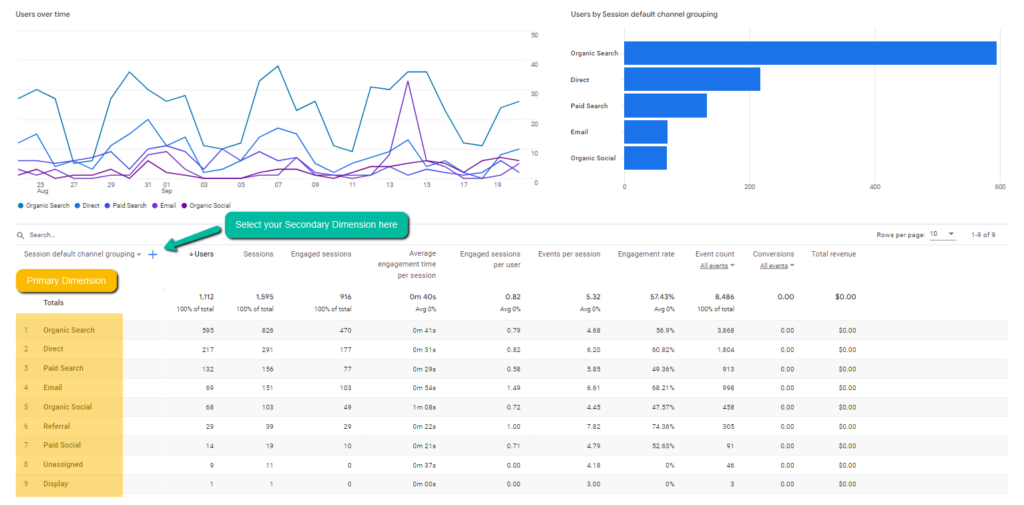Opening the Power of Second Dimension Analytics for Boosted Information Insights and Decision-Making
In the world of data analytics, main measurements often take the limelight, yet the real deepness of understandings exists within the world of additional measurements. By harnessing the power of second dimension analytics, organizations can reveal covert fads, uncover connections, and extract a lot more purposeful final thoughts from their information.
Importance of Additional Dimensions
Checking out the value of secondary dimensions in analytics introduces the concealed layers of information insights critical for educated decision-making in various domains. Additional dimensions offer a deeper understanding of main information by offering extra context and point of views. By incorporating additional measurements right into analytics, companies can remove more thorough and nuanced insights from their datasets.
One trick value of secondary measurements is their capability to section and categorize key data, enabling an extra comprehensive evaluation of particular subsets within a dataset. When looking at the information as a whole, this segmentation allows services to identify patterns, patterns, and outliers that might not be obvious. Additionally, second measurements aid in discovering correlations and dependencies in between different variables, leading to more exact forecasting and predictive modeling.
Additionally, additional dimensions play an essential function in enhancing data visualization and coverage. By including additional dimensions to visualizations, such as charts or graphes, experts can produce extra interesting and insightful representations of data, helping with better communication of findings to stakeholders. In general, the assimilation of additional measurements in analytics contributes in opening the full possibility of information and driving evidence-based decision-making.
Trick Benefits of Using Secondary Measurements
Making use of secondary measurements in analytics offers companies a calculated advantage by boosting the depth and granularity of data understandings. One vital advantage of integrating additional measurements is the ability to sector and filter information, permitting for an extra in-depth analysis of details elements within a dataset. This segmentation allows organizations to get an extra nuanced understanding of their audience, performance metrics, and other crucial information factors. By studying data using second measurements such as time, location, gadget kind, or customer demographics, companies can uncover patterns, fads, and connections that may or else continue to be covert.
Additionally, the usage of secondary dimensions boosts the context in which key information is analyzed. By leveraging second measurements in analytics, organizations can harness the complete possibility of their data to drive much better decision-making and achieve their company objectives.
Advanced Information Analysis Methods
A deep study sophisticated information evaluation techniques discloses sophisticated approaches for extracting useful insights from complex datasets. One such technique is artificial intelligence, where algorithms are used to recognize patterns within information, anticipate outcomes, and make data-driven decisions. This method permits the automation of logical design building, enabling the processing of big volumes of information at a quicker pace than standard techniques.
An additional sophisticated strategy is anticipating analytics, which makes use of statistical algorithms and machine learning methods to anticipate future results based upon historic data. By evaluating fads and patterns, organizations can prepare for customer habits, market patterns, and possible risks, empowering them to make proactive decisions.
Additionally, text mining check over here and belief evaluation are useful strategies for removing understandings from disorganized data resources such as social media sites remarks, client testimonials, and survey responses. By assessing message information, companies can understand customer point of views, determine emerging trends, and enhance their product and services based upon comments.
Enhancing Decision-Making Via Second Measurements

Enhancing decision-making through secondary dimensions enables services to make more notified and targeted critical choices. By segmenting client data based on secondary dimensions like acquiring background or involvement her comment is here levels, companies can tailor their advertising and marketing approaches to specific target market sections, leading to boosted conversion prices and client complete satisfaction. Furthermore, additional measurements can help determine correlations and connections in between different variables, allowing organizations to make data-driven decisions that drive growth and earnings.
Executing Additional Measurement Analytics
When integrating second measurements in analytics, organizations can open much deeper understandings that drive strategic decision-making and enhance overall performance. This involves recognizing the certain questions the company seeks to answer and the information factors called for to resolve them.

Moreover, organizations need to utilize progressed analytics devices and innovations to improve the process of including second measurements. These tools can automate information processing, evaluation, and visualization, enabling organizations to focus on interpreting understandings as opposed to hands-on information adjustment.
Final Thought
In final thought, additional dimension analytics play an essential function in enhancing data understandings and decision-making procedures. By using innovative data analysis methods and carrying out secondary measurements efficiently, companies can unlock the power of their data to drive critical organization decisions.
In the world of information analytics, primary measurements commonly take the spotlight, yet the real depth of understandings lies within the visit this site right here realm of second dimensions.Making use of additional dimensions in analytics supplies companies a calculated advantage by enhancing the deepness and granularity of information understandings. By leveraging second measurements in analytics, organizations can harness the full possibility of their data to drive far better decision-making and achieve their organization goals.
Carrying out data validation procedures and routine audits can aid preserve information top quality and integrity.
By using sophisticated information analysis techniques and applying additional dimensions properly, companies can unlock the power of their information to drive tactical company choices.